Xiaoxue Gao
MultiAiTutor: Child-Friendly Educational Multilingual Speech Generation Tutor with LLMs
Aug 12, 2025Abstract:Generative speech models have demonstrated significant potential in personalizing teacher-student interactions, offering valuable real-world applications for language learning in children's education. However, achieving high-quality, child-friendly speech generation remains challenging, particularly for low-resource languages across diverse languages and cultural contexts. In this paper, we propose MultiAiTutor, an educational multilingual generative AI tutor with child-friendly designs, leveraging LLM architecture for speech generation tailored for educational purposes. We propose to integrate age-appropriate multilingual speech generation using LLM architectures, facilitating young children's language learning through culturally relevant image-description tasks in three low-resource languages: Singaporean-accent Mandarin, Malay, and Tamil. Experimental results from both objective metrics and subjective evaluations demonstrate the superior performance of the proposed MultiAiTutor compared to baseline methods.
Confidence-Based Self-Training for EMG-to-Speech: Leveraging Synthetic EMG for Robust Modeling
Jun 13, 2025Abstract:Voiced Electromyography (EMG)-to-Speech (V-ETS) models reconstruct speech from muscle activity signals, facilitating applications such as neurolaryngologic diagnostics. Despite its potential, the advancement of V-ETS is hindered by a scarcity of paired EMG-speech data. To address this, we propose a novel Confidence-based Multi-Speaker Self-training (CoM2S) approach, along with a newly curated Libri-EMG dataset. This approach leverages synthetic EMG data generated by a pre-trained model, followed by a proposed filtering mechanism based on phoneme-level confidence to enhance the ETS model through the proposed self-training techniques. Experiments demonstrate our method improves phoneme accuracy, reduces phonological confusion, and lowers word error rate, confirming the effectiveness of our CoM2S approach for V-ETS. In support of future research, we will release the codes and the proposed Libri-EMG dataset-an open-access, time-aligned, multi-speaker voiced EMG and speech recordings.
PAL: Prompting Analytic Learning with Missing Modality for Multi-Modal Class-Incremental Learning
Jan 16, 2025Abstract:Multi-modal class-incremental learning (MMCIL) seeks to leverage multi-modal data, such as audio-visual and image-text pairs, thereby enabling models to learn continuously across a sequence of tasks while mitigating forgetting. While existing studies primarily focus on the integration and utilization of multi-modal information for MMCIL, a critical challenge remains: the issue of missing modalities during incremental learning phases. This oversight can exacerbate severe forgetting and significantly impair model performance. To bridge this gap, we propose PAL, a novel exemplar-free framework tailored to MMCIL under missing-modality scenarios. Concretely, we devise modality-specific prompts to compensate for missing information, facilitating the model to maintain a holistic representation of the data. On this foundation, we reformulate the MMCIL problem into a Recursive Least-Squares task, delivering an analytical linear solution. Building upon these, PAL not only alleviates the inherent under-fitting limitation in analytic learning but also preserves the holistic representation of missing-modality data, achieving superior performance with less forgetting across various multi-modal incremental scenarios. Extensive experiments demonstrate that PAL significantly outperforms competitive methods across various datasets, including UPMC-Food101 and N24News, showcasing its robustness towards modality absence and its anti-forgetting ability to maintain high incremental accuracy.
Transferable Adversarial Attacks against ASR
Nov 14, 2024


Abstract:Given the extensive research and real-world applications of automatic speech recognition (ASR), ensuring the robustness of ASR models against minor input perturbations becomes a crucial consideration for maintaining their effectiveness in real-time scenarios. Previous explorations into ASR model robustness have predominantly revolved around evaluating accuracy on white-box settings with full access to ASR models. Nevertheless, full ASR model details are often not available in real-world applications. Therefore, evaluating the robustness of black-box ASR models is essential for a comprehensive understanding of ASR model resilience. In this regard, we thoroughly study the vulnerability of practical black-box attacks in cutting-edge ASR models and propose to employ two advanced time-domain-based transferable attacks alongside our differentiable feature extractor. We also propose a speech-aware gradient optimization approach (SAGO) for ASR, which forces mistranscription with minimal impact on human imperceptibility through voice activity detection rule and a speech-aware gradient-oriented optimizer. Our comprehensive experimental results reveal performance enhancements compared to baseline approaches across five models on two databases.
VoiceBench: Benchmarking LLM-Based Voice Assistants
Oct 22, 2024

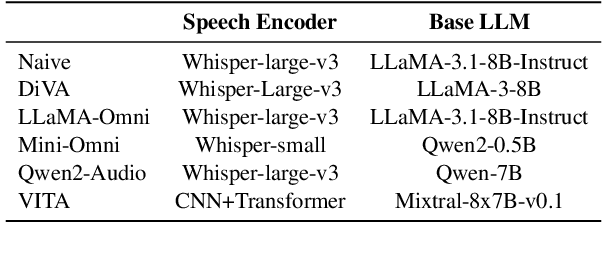
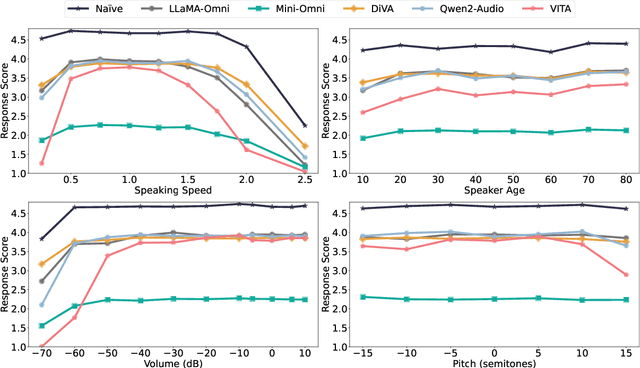
Abstract:Building on the success of large language models (LLMs), recent advancements such as GPT-4o have enabled real-time speech interactions through LLM-based voice assistants, offering a significantly improved user experience compared to traditional text-based interactions. However, the absence of benchmarks designed to evaluate these speech interaction capabilities has hindered progress of LLM-based voice assistants development. Current evaluations focus primarily on automatic speech recognition (ASR) or general knowledge evaluation with clean speeches, neglecting the more intricate, real-world scenarios that involve diverse speaker characteristics, environmental and content factors. To address this, we introduce VoiceBench, the first benchmark designed to provide a multi-faceted evaluation of LLM-based voice assistants. VoiceBench also includes both real and synthetic spoken instructions that incorporate the above three key real-world variations. Extensive experiments reveal the limitations of current LLM-based voice assistant models and offer valuable insights for future research and development in this field.
Speech-Mamba: Long-Context Speech Recognition with Selective State Spaces Models
Sep 27, 2024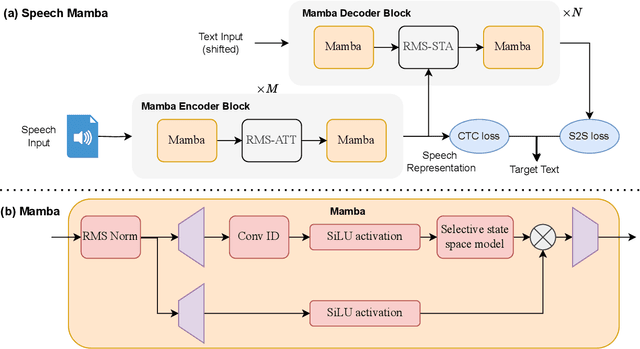



Abstract:Current automatic speech recognition systems struggle with modeling long speech sequences due to high quadratic complexity of Transformer-based models. Selective state space models such as Mamba has performed well on long-sequence modeling in natural language processing and computer vision tasks. However, research endeavors in speech technology tasks has been under-explored. We propose Speech-Mamba, which incorporates selective state space modeling in Transformer neural architectures. Long sequence representations with selective state space models in Speech-Mamba is complemented with lower-level representations from Transformer-based modeling. Speech-mamba achieves better capacity to model long-range dependencies, as it scales near-linearly with sequence length.
Beyond Single-Audio: Advancing Multi-Audio Processing in Audio Large Language Models
Sep 27, 2024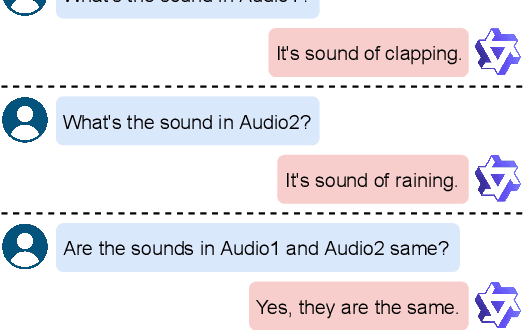
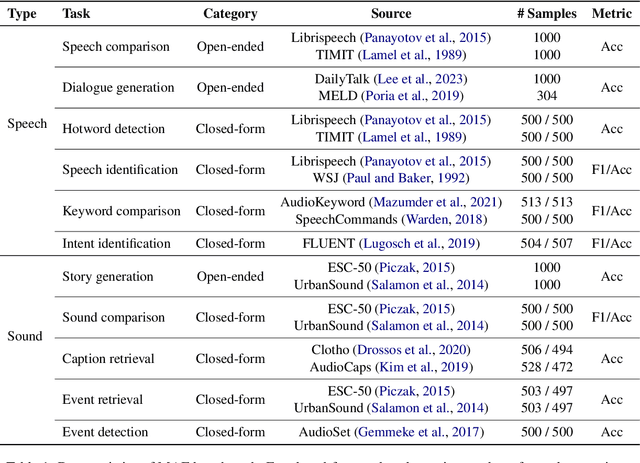
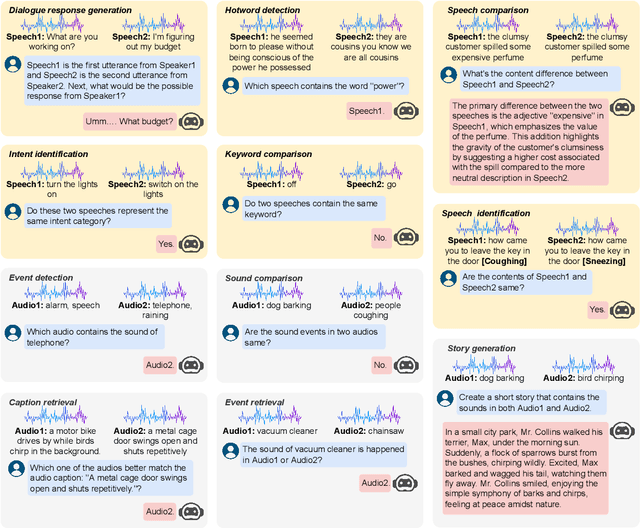
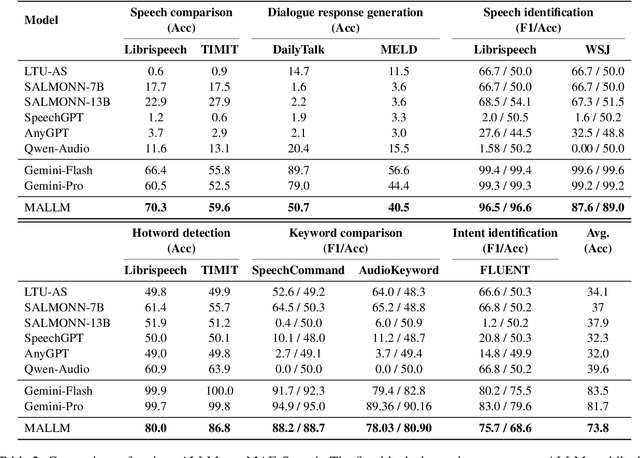
Abstract:Various audio-LLMs (ALLMs) have been explored recently for tackling different audio tasks simultaneously using a single, unified model. While existing evaluations of ALLMs primarily focus on single-audio tasks, real-world applications often involve processing multiple audio streams simultaneously. To bridge this gap, we propose the first multi-audio evaluation (MAE) benchmark that consists of 20 datasets from 11 multi-audio tasks encompassing both speech and sound scenarios. Comprehensive experiments on MAE demonstrate that the existing ALLMs, while being powerful in comprehending primary audio elements in individual audio inputs, struggling to handle multi-audio scenarios. To this end, we propose a novel multi-audio-LLM (MALLM) to capture audio context among multiple similar audios using discriminative learning on our proposed synthetic data. The results demonstrate that the proposed MALLM outperforms all baselines and achieves high data efficiency using synthetic data without requiring human annotations. The proposed MALLM opens the door for ALLMs towards multi-audio processing era and brings us closer to replicating human auditory capabilities in machines.
Emo-DPO: Controllable Emotional Speech Synthesis through Direct Preference Optimization
Sep 16, 2024
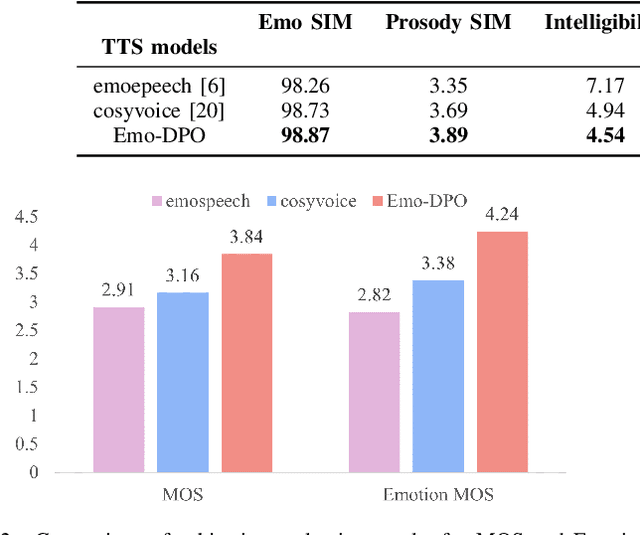


Abstract:Current emotional text-to-speech (TTS) models predominantly conduct supervised training to learn the conversion from text and desired emotion to its emotional speech, focusing on a single emotion per text-speech pair. These models only learn the correct emotional outputs without fully comprehending other emotion characteristics, which limits their capabilities of capturing the nuances between different emotions. We propose a controllable Emo-DPO approach, which employs direct preference optimization to differentiate subtle emotional nuances between emotions through optimizing towards preferred emotions over less preferred emotional ones. Instead of relying on traditional neural architectures used in existing emotional TTS models, we propose utilizing the emotion-aware LLM-TTS neural architecture to leverage LLMs' in-context learning and instruction-following capabilities. Comprehensive experiments confirm that our proposed method outperforms the existing baselines.
MEDSAGE: Enhancing Robustness of Medical Dialogue Summarization to ASR Errors with LLM-generated Synthetic Dialogues
Aug 26, 2024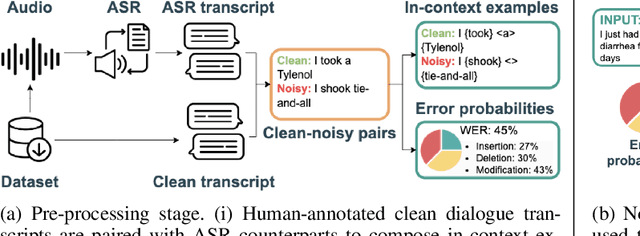
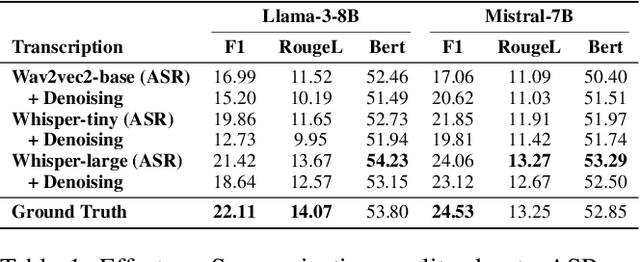


Abstract:Automatic Speech Recognition (ASR) systems are pivotal in transcribing speech into text, yet the errors they introduce can significantly degrade the performance of downstream tasks like summarization. This issue is particularly pronounced in clinical dialogue summarization, a low-resource domain where supervised data for fine-tuning is scarce, necessitating the use of ASR models as black-box solutions. Employing conventional data augmentation for enhancing the noise robustness of summarization models is not feasible either due to the unavailability of sufficient medical dialogue audio recordings and corresponding ASR transcripts. To address this challenge, we propose MEDSAGE, an approach for generating synthetic samples for data augmentation using Large Language Models (LLMs). Specifically, we leverage the in-context learning capabilities of LLMs and instruct them to generate ASR-like errors based on a few available medical dialogue examples with audio recordings. Experimental results show that LLMs can effectively model ASR noise, and incorporating this noisy data into the training process significantly improves the robustness and accuracy of medical dialogue summarization systems. This approach addresses the challenges of noisy ASR outputs in critical applications, offering a robust solution to enhance the reliability of clinical dialogue summarization.
TTSlow: Slow Down Text-to-Speech with Efficiency Robustness Evaluations
Jul 02, 2024



Abstract:Text-to-speech (TTS) has been extensively studied for generating high-quality speech with textual inputs, playing a crucial role in various real-time applications. For real-world deployment, ensuring stable and timely generation in TTS models against minor input perturbations is of paramount importance. Therefore, evaluating the robustness of TTS models against such perturbations, commonly known as adversarial attacks, is highly desirable. In this paper, we propose TTSlow, a novel adversarial approach specifically tailored to slow down the speech generation process in TTS systems. To induce long TTS waiting time, we design novel efficiency-oriented adversarial loss to encourage endless generation process. TTSlow encompasses two attack strategies targeting both text inputs and speaker embedding. Specifically, we propose TTSlow-text, which utilizes a combination of homoglyphs-based and swap-based perturbations, along with TTSlow-spk, which employs a gradient optimization attack approach for speaker embedding. TTSlow serves as the first attack approach targeting a wide range of TTS models, including autoregressive and non-autoregressive TTS ones, thereby advancing exploration in audio security. Extensive experiments are conducted to evaluate the inference efficiency of TTS models, and in-depth analysis of generated speech intelligibility is performed using Gemini. The results demonstrate that TTSlow can effectively slow down two TTS models across three publicly available datasets. We are committed to releasing the source code upon acceptance, facilitating further research and benchmarking in this domain.
 Add to Chrome
Add to Chrome Add to Firefox
Add to Firefox Add to Edge
Add to Edge